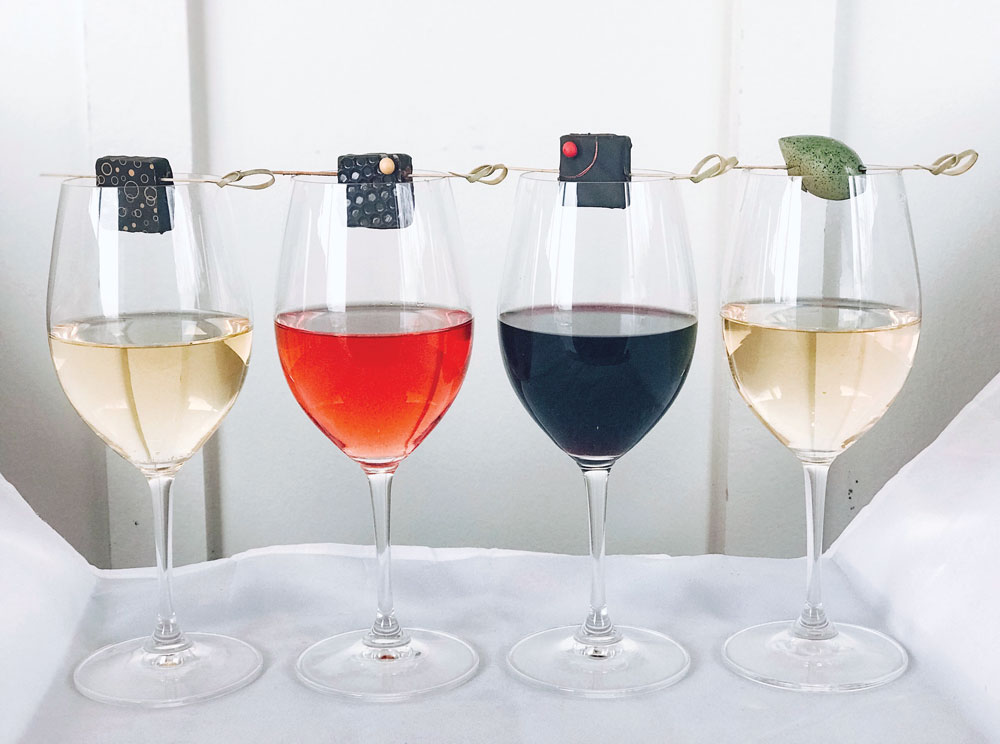Enhance Your Wine Experience with the Right Stemware

By Linda Barrett | Photo by Abbey Veith
I was visiting a local winery recently and noticed on the tasting glass the word “Riedel” etched tastefully into its base. I was impressed because this meant that the winery recognized that the type of stemware used to serve its wine – even for a tasting – could make a profound difference in its enjoyment. The better crystal and thinner glass seem to enhance the wine tasting experience, as does the shape and size.
Does Shape Matter? “For me, the glass does make a difference,” said Michael Pearce, sommelier and owner of the Vine House in Fairfax and Vino Bistro in Leesburg. “You can put a $300 bottle of wine inside a glass with a bowl and a rolled rim and you won’t get much; put the same wine in a glass of an appropriate shape with a cut rim and you’ll get full enjoyment.”

“It’s about how the wine is delivered to the palate,” he continued. “There are different sized and shaped glasses. A Bordeaux glass delivers wine to the middle of the palate. The Burgundy glass, a rounder glass, delivers the wine more to the front of the palate, focusing on the fruit.”
“The aroma has different densities too: fruit on the top, vegetal in the middle, alcohol and wood on the bottom. The aromatics stay on top of the wine so when you swirl the glass you open up the airborne aromatics, the volatile esters.”
Notice the rim. “The rim of an inexpensive glass has a little rolled rim. You don’t want that little rim. It dissipates wine all over the palate,” he explained. It can also accentuate any acidity and harshness in the wine. The best rim is one that has been laser cut to provide a thin edge. The thickness or thinness of a glass is a personal preference, although thinner stemware carries a bit more elegance.
Noted Stemware Manufacturers
Founded in the 1600s, Riedel is one of the higher-end glassware manufacturers. This 11th generation family-owned company focuses on educating the public on how stemware influences wine. Through illustrations of various glasses and wine education materials located on the website, Riedel demonstrates how best to enjoy wine using the shape, size and rim diameter of its glass to suit each style.
Austrian manufacturer Zalto is another high-end glassmaker. It offers lightweight, hand-blown lead-free crystal glassware often used at top restaurants and wine programs. Featuring ultra-thin bowls and stiletto-type stems, they may seem too delicate to hold, but in reality, they are sturdy enough for everyday use. Interestingly, Zalto’s Denk’Art series’ design was influenced by the earth, with the curve of the bowls tilted at the angles of 24, 48 and 72 degrees—in accordance to the tilt angle of the Earth. This triumvirate of angles was used by the ancient Romans for their supply repositories, finding that produce stayed fresher longer and had improved taste. The same parallels were made in the wine glasses.
“The best investment you can make if you’re thinking about enjoying and learning about wine is in your stemware,” Pearce commented. However, he adds that you don’t have to purchase the highest-priced glasses to get the best results. “Schott Zwiesel is another brand that is equally good and way less expensive.” Ravenscroft crystal wine glasses are an additional affordable alternative. Pearce’s favorite glass to use at home? “A general all-round Bordeaux glass.”
The Shapes of Wine Glasses
Wine glasses come in many sizes and shapes, and are defined in a number of ways:
- Size and shape of bowl
- Stem length
- Stemless
- Lead crystal vs. regular glass
- Plain, colored or etched
- Champagne/sparkling wine flutes
Larger bowls allow air to reach more of the wine’s surface, allowing reds to evolve and open up, while the slim glass shape of the flutes allow bubbles to manifest with the greatest intensity and duration. Plain, unadorned glasses are best for noting the color and viscosity of the wine, and finer, thinner crystal glassware can enhance the wine drinking experience.
Glassware for Red Wines
Red wine glasses often fall into these categories:
- Cabernet/Merlot/Bordeaux: the “standard” red wine glass with a full bowl and a taper on top
- Pinot/Burgundy: with a much wider bowl
- Shiraz: the tallest red wine glass with a distinct top taper
- Port: a short, small glass
Glassware for White Wines
White wine glasses often fall into these categories:
- Chardonnay: the “standard” white wine glass
- Sauvignon Blanc/Pinot Grigio: shorter, with a smaller bowl designed to bring out the acidity in wines
- Montrachet/White Burgundy: similar to the Red Burgundy or Pinot Noir glass, but shorter
Dessert wines are most often served in port or sherry-style glassware. How each person interprets their wine is as individual as their personalities, but having the right stemware can certainly help bring to the forefront its many pleasures and intricacies.
This article first appeared in the July 2019 issue of Middleburg Life.


